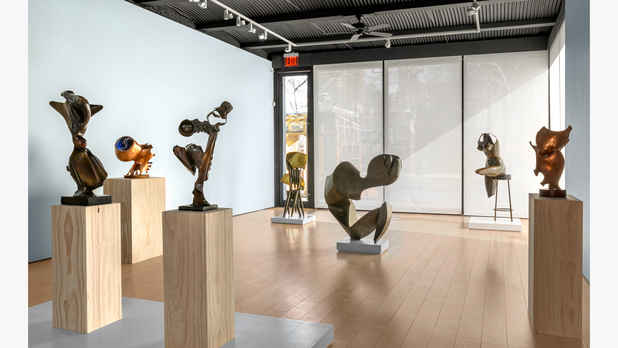James Metcalf “Hammer and Hand”
Kasmin (297 10th Ave.)

This event has ended.
Kasmin presents Hammer and Hand, a new exhibition of sculpture by James Metcalf (1925–2012). Bringing together works spanning almost 60 years and demonstrating the American artist’s startlingly original vocabulary of forms and techniques, the exhibition will be the first at the gallery dedicated to Metcalf’s practice and is staged in close collaboration with his family. A new essay by the artist’s biographer, Roy Skodnick, will be published on the occasion of the exhibition.
The formal elegance of Metcalf’s oeuvre speaks to his profound mastery of metal. Rendering works splendidly in copper, iron, and brass, the artist blends the biomorphic character of post-war surrealism with an obsession with material and the collaborative world of artisans. His sensibility is grounded by a comprehensive knowledge of Gothic, Romanesque and Medieval art as well as a technical interest in Art Deco and Art Nouveau. Metcalf voraciously studied and drew inspiration from various metalwork techniques, especially those of ancient Greco-Roman civilizations, while engaging stylistically with Celtic art’s surface ornament and proliferation of animal forms. After initially eschewing power tools for manually operated ones, the artist later included machinery and invented implements to coax his stylistic forms, guided by the belief that form should follow material.
In earlier works, forged during his time in London and Deià, he worked with iron. Later works such as Lady Macbeth (1959) and The Barfly (1963) were hammered and welded from sheets of brass and copper. Metcalf’s mature work was influenced by topology, the mathematics of transformation of volume in torsions where outer and inner join and volume moves through itself. This study informed his sense of what was possible with metal and the forms that would comprise his singular style.
Art Historian Sam Hunter wrote in 1961, “Metcalf’s impact is somehow more passionate, barbaric and psychologically disquieting than that of the conventional welder. His forms are almost precious in the refined beauty of their surfaces, and disturbing in their associations, with nerve centers of saw-teeth, or rippling lines, or simply torn metal.”
In 1956 Metcalf moved to Paris, where friend and former resident, William N. Copley, set him up with a studio at Impasse Ronsin. The cluster of studios in Montparnasse was longtime home to Constantin Brancusi, and at different times Max Ernst, Yves Klein, Niki de Saint Phalle, and Jean Tinguely, to name a few. Metcalf became known as “the American who knew everything about metal,” and experimented with Francois-Xavier and Claude Lalanne in the technique of electro-plating. He helped Tinguely weld the edges of his satirical machines, making them “too beautiful” for Tinguely’s taste, and shot paintings with de Saint Phalle. It was in this famed European bohemia of creation and collaboration that Metcalf’s unique style matured. Metcalf also met and mingled with the older guard of Surrealists—Marcel Duchamp, Man Ray, and Rene Magritte—whose artistic and intellectual influence is clear in the sculptor’s three-dimensional renderings.
Media
Schedule
from March 03, 2022 to April 23, 2022